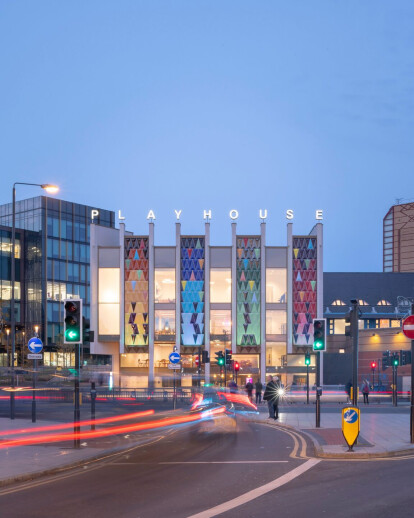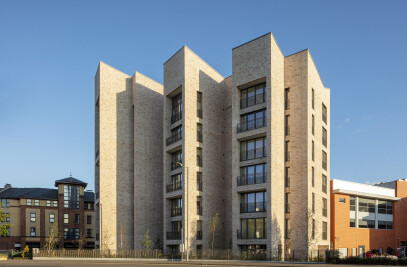EXISTING
At the outset of the project Leeds Playhouse was a labyrinth of seemingly unsolvable problems. Built facing the wrong direction, it was intended to address a wider development that never materialised. Designed in the 1980’s the interiors had grown tired, the site topography resulted in complex levels and a convoluted and inaccessible entrance sequence. Designed by the Appleton Partnership and opened in 1990, the building contains two theatre spaces – the Quarry, a fan shaped tiered auditorium (based on the original temporary theatre in which the organisation had been housed on the Leeds University campus) and the Courtyard Theatre, a galleried flexible space with a retractable seating bank - and was considered a seminal design at the time.
BRIEF
With the city of Leeds undergoing a period of significant investment and change,including a renewed focus on the value of culture to the city and major new developments in the vicinity of the theatre, thiswas a timely opportunity for Leeds Playhouseto address the significant issues with the existingbuilding, not least the fact that the current building effectively faces away from the city centre and is isolated by the ring road system. A key aim ofthe redevelopment is tore-orientate the entrance, reconnecting thetheatre with the city. Fundamental to the redevelopment was the need to make the building more accessible in every sense - not just physically - in order to better support the sector-leading work that the Playhouse already undertakes on and off its stages.
DEVELOPMENT OF THE BRIEF
Page\Park Architects were appointed in early 2016 after a competitive process to work with the client Leeds City Council and Leeds Playhouse as end users on the capital redevelopment. Our immediate response was that, whilst a focus on the creation of a new entrance to give the organisation a stronger visual identity was important, there were other fundamental issues that needed to be addressedto meet the expectation of today’s audiences in terms of facilities, accessibility and inclusivity.
KEY DESIGN MOVES
QUARRY
How to better integrate the wheelchair and companion spaces into the heart of the Quarry Theatre audience was a key component of our proposals, and the idea of democratic access for all drove the decision-making process behind the internal alterations to the auditorium and the wider building.
Having observed the difficulties of accessing at the top of the steep rake, and the segregation of wheelchair users and their companions at the periphery of the auditorium, we proposed new vomitory entrances at mid-tier level to enable everyone to enter the space unassisted, and to embed the wheelchair and companion positions within the body of the audience. These new entrances then related to a new foyer and route driven through the core of the building, to more closely connect the theatre spaces with the foyer and encourage movement and exploration.
COURTYARD
Leeds Playhouse were keen to increase the seating capacity in the Courtyard by introducing a shallower rake of fixed stalls seating and working with venue consultants Charcoalblue a new arrangement was developed to provide an extra three rows of seating, not dissimilar to the Dorfman Theatre at the National.
ROCK VOID
There was a lot of discussion around the Bramall Rock Void and the nature of this as an ‘as found’ space, which maintains the rawness of the existing brickwork and concrete soffits and a heightened sense of entering into the bowels of the building through the entrance sequence.
Whilst the original design had cleverly utilised the topography to minimise the bulk of the Quarry Theatre, it resulted in a building with a complicated arrangement of internal levels.
EXTENSION
The completed project comprises the new entrance extension onto St Peters Street (with a large new passenger lift), a re-imagined original entrance onto Playhouse Square and further proposed future developments (important to maintain as this is where taxi and coach drop off and accessible parking bays are sited)and the formation of a new internal foyer at the mid-level of the building to connect the entrances and provide improved access and connection into the Quarry and Courtyard. The box office is relocated to the literal heart of the building, opening up to a newly landscaped area named Playhouse Gardens that provides an accessible outsidelink between St Peters Street and Playhouse Square, and connects the Playhouse with the newly built creative arts campus of Leeds City College.
The circulation now creates a route through the theatre – offering the prospect of chance encounters with the performing arts and other activities hosted by Leeds Playhouse.
IDENTITY
The use of ceramics externally roots the façade in the strong local tradition of ceramic and faience seen around Leeds. In our research on the historical context of the site we learnt about Burmantofts Pottery, with their colourful ceramics made locally but exported globally,and we discovered an appropriate synergy with Playhouse productions that are very frequently ‘local’ in content yet focus on universal themes that allow them to be toured nationally and internationally.
Ceramicenabled us to exploit the plasticity of the material to create a three-dimensional façade that alters with the light conditions, with the trapezoidal form linking back to the geometries of the original building. As professional story tellers, Leeds Playhouse pushed us to develop a strong narrative behind the pattern of these panels and the idea emerged of the actor standing on the stage being represented into the patterning on each of the four panels, with each panel depicting one of the four main spaces (Quarry, Courtyard, Bramall Rock Void and Barber Studio). The black tiles represent the actor in the foot lights looking out at their audience, with the fading of the colours into darkness. Each panel is lit from the bottom (representing the stage foot lights) with the light fading out as you eye rises up the panels.
Despite being diminutive in scale against the neighbouring buildings, the new entrance has an assertive presence on St Peters Street, in part due to the roofline and the symbolic Playhouse capital letters – which are themselves reminiscent of the original Leeds Playhouse on Leeds University campus - furtherconnecting the new extension back to the origins of the theatre.
The motif of the ceramic elements is referenced internally in the wayfinding and other internal elements to create a strong holistic visual identity for the Leeds Playhouse resonating with the new brand. Even before Leeds Playhouse has officially reopened this entrance façade has created a real buzz on social media, heightening the anticipation of the theatre’s reopening.
ENHANCING SUSTAINABILITY AND INCLUSIVITY
Improving the resilience of Leeds Playhouse was a major objective of the project and the environmental sustainability agenda a critical part of this.The reimagining of the existing building is inherently sustainable and outdated mechanical and electrical systems have been replaced with more efficient versions. Opportunities for the Playhouse to generate its own revenue have been significantly enhanced through the creation of new and improved catering and conferencing facilities.
There has been an emphasis on making Leeds Playhouse as inclusive as possible, reflecting the organisation’s vision and values. The toilet provision is comprehensive, with provision for both gender and non-gender assigned facilities, family friendly cubicles and compartments, and retaining aChanging Places facility.
SIGNAGE
Our signage commission looked to strengthen the visual identity of the new façade, and so the tile motif formed a key part of the wayfinding concept. Having been involved in all facets of the project we were able to start the concept design at a much more advanced stage.
The geometry of the façade, the colours of the ceramics and the tones of the internal finishes were all blended to create a holistic wayfinding scheme for Leeds Playhouse. As part of our process we examined visitor, performers, audience and staff routes through the building to integrate the most appropriate location for signage to be installed. We worked collaboratively with the client’s digital signage contractor to explore the fusion between digital and physical signage.
SUMMARY
The new entrance extension delivers a strong visual identity for not only Leeds Playhouse but also the wider cultural quarter located in Quarry Hill. The theatre building can nowbetter support the artistic, Creative Engagement and Furnace artist development programmes, enabling Leeds Playhouse to remain a key player in Leeds City Council’s commitment to delivering a world class cultural programme,embedding culture at the heart of the city.
Client Testimonial
James Brining Executive Director
The transformed Leeds Playhouse marks the most exciting new chapter in our history for decades and we can’t wait to welcome everyone to enjoy and explore. The new building will allow us to offer the magic of theatre to everyone, all under one roof. I’m so excited for all our venues to function together and it’s our hope that the Autumn/Winter programme will give a taste of what we’re about: a theatre that is rooted in its local community, producing work of national and international significance and supporting and developing artists at all stages of their career.
“There is a tangible buzz around culture in Leeds right now – with the relocation of Channel 4 and the upcoming plans for Leeds 2023, this really is the most fantastic time to be re-opening a theatre that the whole city can be proud of.”
Robin Hawkes Executive Director
“It is just fantastic to see the transformation which Page\Park have conceived landing so well with people as they begin to come back inside the building.”


































